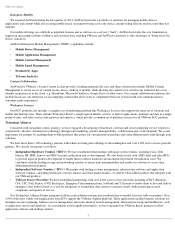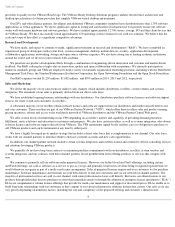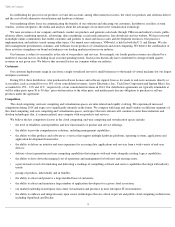VMware 2014 Annual Report Download - page 19
Download and view the complete annual report
Please find page 19 of the 2014 VMware annual report below. You can navigate through the pages in the report by either clicking on the pages listed below, or by using the keyword search tool below to find specific information within the annual report.
Table of Contents
responsible. If that were to happen, our ability to deliver services at levels acceptable to our customers and at levels that we have committed to
could be impaired. Additionally, if the third parties that we rely on do fail to deliver on their obligations, our reputation could be damaged, our
customers could lose confidence in us, and our ability to maintain and expand our vCloud Air offerings would be impaired.
Ongoing uncertainty regarding global economic conditions and the stability of regional financial markets may reduce information
technology spending below current expectations and therefore adversely impact our revenues, impede end-
user adoption of new products and
services and product and service upgrades, and adversely impact our competitive position.
Our business depends on the overall demand for information technology and on the economic health of our current and prospective
customers. The purchase of our products and services is often discretionary and may involve a significant commitment of capital and other
resources. Weak economic conditions or significant uncertainty regarding the stability of financial markets could adversely impact our business,
financial condition and results of operations in a number of ways, including by lengthening sales cycles, affecting the size of enterprise license
agreements (“ELAs”) that customers will commit to, reducing the level of our non-ELA transactional sales, lowering prices for our products and
services, reducing unit sales and reducing the rate of adoption of our products and services by new customers and the willingness of current
customers to purchase upgrades to our existing products and services. For example, a recurrence of the sovereign debt crisis in Europe or that
region’s failure to recover from recession would threaten to suppress demand and our customers’ access to credit in that region, which is an
important market for our products and services. Additionally, in response to sustained economic uncertainty, many national and local
governments that are current or prospective customers for our products and services, including the U.S. federal government, have made, or
threatened to make, significant spending cutbacks which could reduce the amount of government spending on IT and the potential demand for
our products and services from the government sector.
Regional economic uncertainty can also result in general and ongoing tightening in the credit markets, lower levels of liquidity, increases in
the rates of default and bankruptcy and significant volatility in the credit, equity and fixed income markets. As a result, current or potential
customers may be unable to fund software purchases, which could cause them to delay, decrease or cancel purchases of our products and
services. Even if customers are willing to purchase our products and services, if they do not meet our credit requirements, we may not be able to
record accounts receivable or unearned revenues or recognize revenues from these customers until we receive payment, which could adversely
affect the amount of revenues we are able to recognize in a particular period.
In addition, although we plan to continue making strategic investments in our business, many of our competitors have significantly greater
financial, technical and other resources than we do, and to the degree that the economic recovery is anemic or not sustained, they may be better
positioned to continue investment in competitive technologies.
Our revenues, unearned revenues, collection of accounts receivable and financial results may be adversely impacted by fluctuation of foreign
currency exchange rates. Although foreign currency hedges can offset some of the risk related to foreign currency fluctuations, we will
continue to experience foreign currency gains and losses in certain instances where it is not possible or cost effective to hedge our foreign
currency exposures.
Our revenues, unearned revenues, and our collection of accounts receivable may be adversely impacted as a result of fluctuations in the
exchange rates between the U.S. dollar and foreign currencies. For example, we have distributors in foreign countries that may incur higher costs
in periods when the value of the U.S. dollar strengthens against foreign currencies. One or more of these distributors could delay payments or
default on credit extended to them as a result. Any significant delay or default in the collection of significant accounts receivable could result in
an increased need for us to obtain working capital from other sources. If we determine that the amount of accounts receivable that is
uncollectible is greater than our estimates, we would recognize an increase in bad debt expense, which would have a negative impact on our
results of operations. In addition, in periods when the value of the U.S. dollar strengthens, we may need to offer additional discounts, reduce
prices or offer other incentives to mitigate the negative effect on demand.
We invoice and collect in certain non-U.S. dollar denominated currencies, thereby conducting a portion of our transactions in currencies
other than the U.S. dollar. Although this practice may alleviate credit risk from our distributors during periods when the U.S. dollar strengthens,
it shifts the risk of currency fluctuations to us and may negatively impact our revenues, unearned revenues, anticipated cash flows and financial
results due to fluctuations in foreign currency exchange rates, particularly the euro, the British pound, the Japanese yen, the Australian dollar and
the Chinese renminbi relative to the U.S. dollar. While variability in operating margin may be reduced due to invoicing in certain of the local
currencies in which we also recognize expenses, increased exposure to foreign currency fluctuations will introduce additional risk for variability
in revenue-related components of our consolidated financial statements. In 2014 approximately 30% of our sales were invoiced and collected in
certain non-U.S. dollar denominated currencies.
We enter into foreign currency forward contracts to hedge a portion of our net outstanding monetary assets and liabilities against movements
in certain foreign exchange rates. Although we expect the gains and losses on our foreign currency forward contracts to generally offset the
majority of the gains and losses associated with the underlying foreign-currency denominated
17
























